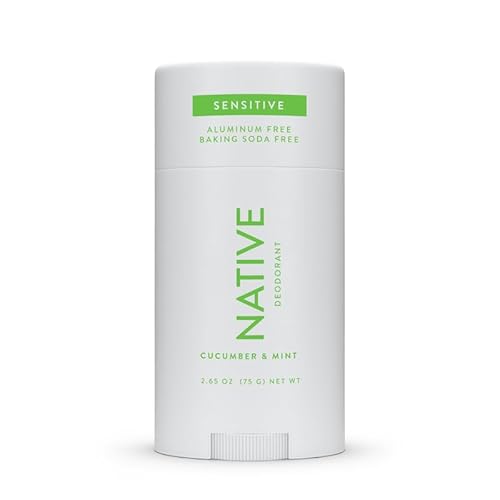
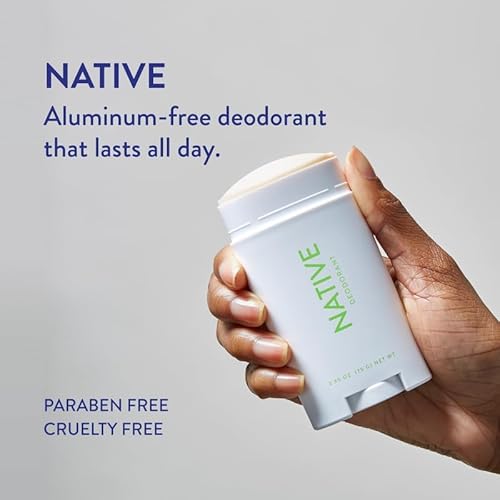
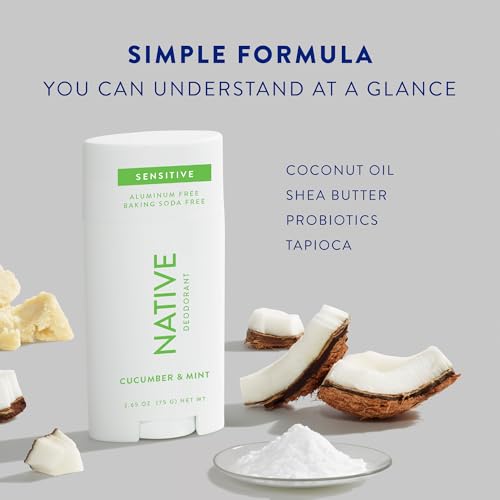
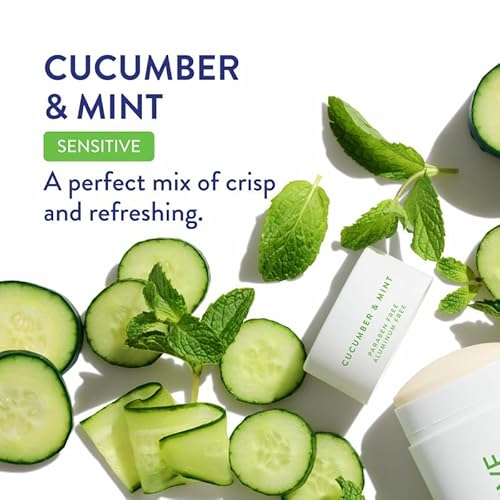
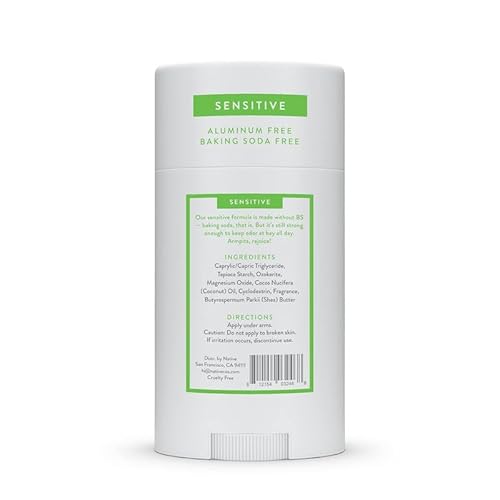
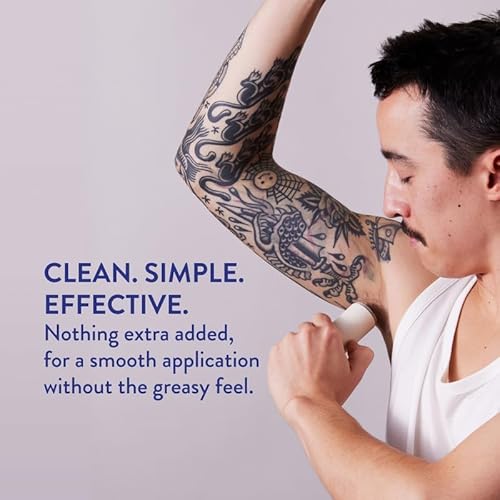
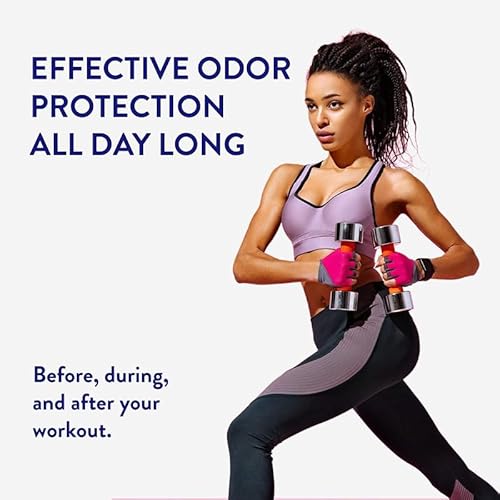
Native Sensitive Deodorant - 72-Hour Odor Control, Aluminum Free, Cucumber & Mint - 2.65oz


Fragrance
High RiskFragrance refers to a mixture of aromatic compounds used in products to provide scent. It is commonly listed as 'fragrance' or 'parfum' on product labels and can serve various functions, including enhancing user experience and masking undesirable odors.
Sustai Insights
Fragrance offers functional benefits by improving product appeal; however, it poses significant health risks, notably a high likelihood of causing allergies and allergic contact dermatitis. Environmental risks include potential pollution and endocrine disruption, though its overall carcinogenicity is low. Regulatory bodies have noted concerns regarding its use, leading to a high-risk classification. Safe usage practices should be observed, and alternatives such as natural essential oils are recommended for those sensitive to synthetic fragrances.
Glyceryl Undecylenate
Medium RiskGlyceryl undecylenate is an ester of glycerin and undecylenic acid, commonly used as a skin-conditioning agent and emulsifier in cosmetic formulations. It aids in improving the texture and spreadability of products, contributing to their overall performance.
Sustai Insights
Glyceryl undecylenate offers functional benefits as an effective emulsifier and skin-conditioning agent. It is generally recognized as safe with low concerns regarding carcinogenicity, allergies, and reproductive toxicity. However, moderate use restrictions exist, and regulatory advisories should be considered. Environmental risks are minimal, with no significant pollutant or bioaccumulation potential noted. Overall, the risk assessment indicates a medium-level risk, making it essential to follow safe usage practices and consider alternatives like glycerin or natural oils for sustainability.
Acidophilus Extract
Low RiskAcidophilus extract is derived from the Lactobacillus acidophilus bacteria, commonly used in dietary supplements and fermented foods. It functions primarily as a probiotic, aiding in the maintenance of gut health by promoting a balanced intestinal microbiota.
Sustai Insights
Acidophilus extract offers functional benefits as a probiotic, supporting digestive health and immune function. It is generally recognized as safe with low concerns regarding carcinogenicity, allergies, and developmental toxicity. Environmental risks are minimal, and it is not associated with bioaccumulation. Regulatory bodies do not impose restrictions on its use. Overall, the risk level is low, and it can be safely included in health-related products, with few alternatives necessary.
Glucose
Low RiskGlucose is a simple sugar commonly derived from starches and is utilized primarily as a sweetener in food and beverages. It serves as an energy source for cellular processes and is also used in various pharmaceutical and cosmetic formulations for its humectant properties, helping to retain moisture.
Sustai Insights
Glucose offers functional benefits as a sweetener and humectant, enhancing product texture and moisture retention. Its sustainability credentials are moderate, as it is often derived from renewable sources. Health risks are low, with no significant concerns regarding carcinogenicity or allergenic potential. Environmental risks are minimal, as glucose is not considered a pollutant or bioaccumulative. Regulatory agencies, including the FDA, do not impose restrictions on glucose use, confirming its safety in approved concentrations. Overall, glucose carries a low risk profile, making it a favorable ingredient in various applications.
Jojoba Esters
Low RiskJojoba esters are a complex mixture of esters produced from the oil of the jojoba plant (Simmondsia chinensis). They serve primarily as emollients and skin conditioning agents in cosmetic formulations, enhancing texture and moisture retention.
Sustai Insights
Jojoba esters provide effective moisturizing properties, contributing to skin conditioning and improving product feel. They are sustainably sourced and biodegradable, posing low risk for carcinogenicity, allergies, and developmental toxicity. Environmental risks are minimal, with no significant pollutants or bioaccumulation concerns. Regulatory agencies have not imposed restrictions, indicating a low overall risk assessment. Safe usage practices should include monitoring for any allergic reactions, although such occurrences are rare. Alternatives, such as synthetic emollients, may be considered, but jojoba esters remain a low-risk option.
Glycine Soja (Soybean) Oil
Low RiskGlycine soja (soybean) oil is derived from the seeds of the soybean plant and is commonly used in cosmetic formulations for its emollient properties. It functions as a moisturizer and skin conditioning agent, enhancing the texture and feel of products.
Sustai Insights
Glycine soja (soybean) oil offers functional benefits such as effective skin moisturization and conditioning. It is generally recognized as low-risk for health concerns, with minimal allergenic potential and no significant environmental hazards reported. Regulatory bodies have not imposed restrictions on its use. Overall, this ingredient is assessed as low risk, making it a suitable option for various cosmetic applications.
Hydrogenated Castor Oil
Low RiskHydrogenated castor oil is produced by hydrogenating castor oil, resulting in a thick, waxy substance. It functions primarily as an emollient and thickening agent in various cosmetic and personal care products, enhancing texture and stability.
Sustai Insights
Hydrogenated castor oil serves as an effective emollient and thickener, contributing to product stability and texture. It is generally regarded as low risk for health impacts, with low concerns for carcinogenicity, allergies, and reproductive toxicity. Environmentally, it presents low pollutant potential and does not bioaccumulate. Regulatory bodies impose low restrictions, making it a compliant choice in formulations. Safe usage practices should be followed, and while no significant alternatives are highlighted, its overall risk level remains low.
Magnesium Hydroxide
Low RiskMagnesium hydroxide is an inorganic base commonly used in various applications, including as an antacid and laxative. It serves to neutralize stomach acid and relieve constipation. It is also utilized in wastewater treatment and as a flame retardant in plastics.
Sustai Insights
Magnesium hydroxide provides effective relief from indigestion and constipation, contributing to digestive health. It is recognized for its low environmental impact and is generally regarded as safe with minimal health risks, including low concerns for carcinogenicity, allergies, and reproductive toxicity. Regulatory bodies have few restrictions on its use, classifying it as low risk overall. However, precautions should be taken to avoid excessive consumption, and alternatives like calcium carbonate may be considered for similar functions. Overall, magnesium hydroxide is assessed as low risk.
Polyglyceryl 3 Beeswax
Low RiskPolyglyceryl-3 beeswax is an ester derived from beeswax and polyglycerin. It functions primarily as an emulsifier and thickening agent in cosmetic formulations, helping to blend oil and water components effectively.
Sustai Insights
Polyglyceryl-3 beeswax offers functional benefits as an effective emulsifier, enhancing product stability and texture. It is considered low risk regarding health impacts, with minimal concerns related to irritation or allergies. Environmentally, it does not pose significant pollution or bioaccumulation risks. Regulatory bodies have not placed restrictions on its use. Overall, safe usage is supported, and alternatives may include synthetic emulsifiers. The ingredient is assessed as low risk.
Stearyl Alcohol
Low RiskStearyl alcohol is a compound produced from the hydrogenation of stearic acid, commonly used in cosmetic formulations as an emulsifier and thickening agent. It helps stabilize products by blending oil and water phases, enhancing texture and consistency.
Sustai Insights
Stearyl alcohol provides functional benefits as an emulsifier and stabilizer, contributing to improved product texture. It is generally regarded as safe with low concerns for cancer, allergies, and reproductive toxicity. However, it may cause moderate skin, eye, or respiratory irritation. Regulatory bodies do not impose significant restrictions, indicating a low overall risk. While it poses minimal health and environmental hazards, caution is advised for sensitive individuals. Alternatives like cetyl alcohol or plant-based emulsifiers may offer safer options for formulators.
Maranta Arundinacea (Arrowroot)
Low RiskMaranta arundinacea, commonly known as arrowroot, is a starch obtained from the roots of the arrowroot plant. It is primarily used as a thickening agent in various food products and as a stabilizer in cosmetics and personal care items.
Sustai Insights
Arrowroot offers functional benefits as a thickener and stabilizer, and is often considered a gluten-free alternative in food applications. It is sustainably sourced and biodegradable. Health risks are minimal, with low concerns regarding carcinogenicity, allergies, or reproductive toxicity. Environmental risks are also low, as it does not significantly pollute or bioaccumulate. Regulatory status indicates no current restrictions. Overall, arrowroot presents a low risk profile, making it a favorable ingredient choice.
Glyceryl Caprylate
Low RiskGlyceryl caprylate is a monoester of glycerin and caprylic acid, commonly used in cosmetics and personal care products as an emulsifier and skin-conditioning agent. It helps stabilize formulations and improve the texture and feel on the skin.
Sustai Insights
Glyceryl caprylate offers functional benefits as an effective emulsifier and skin-conditioning agent, enhancing product performance. It is biodegradable and considered sustainably sourced. Health risks are low, with minimal concerns regarding carcinogenicity, allergenic potential, and endocrine disruption. Environmental risks are also low, with no significant pollutant or bioaccumulation potential identified. Regulatory status is favorable, with no major restrictions. Overall, glyceryl caprylate maintains a low risk profile, making it a suitable ingredient for use in cosmetic formulations.
Tocopherol
Low RiskTocopherols are a class of naturally occurring compounds, primarily known for their role as antioxidants. They are commonly used in cosmetic and skincare products to help stabilize formulations and protect ingredients from oxidative damage.
Sustai Insights
Tocopherols provide functional benefits such as antioxidant protection and skin conditioning. They are generally recognized as safe, with low concerns regarding carcinogenicity, allergies, and reproductive toxicity. However, enhanced skin absorption and potential endocrine disruption are noted. Regulatory bodies have not imposed significant restrictions on tocopherols, categorizing the overall risk as low. Safe usage practices should be observed, and while alternatives exist, tocopherols remain a viable option in formulations.
Caprylic/Capric Triglyceride
Low RiskCaprylic/capric triglyceride is a mixed triester derived from coconut oil and glycerin, primarily used as an emollient and skin-conditioning agent in cosmetic formulations. It serves to improve the texture and spreadability of products while providing a lightweight, non-greasy feel on the skin.
Sustai Insights
Caprylic/capric triglyceride offers functional benefits as an effective emollient, enhancing skin hydration without clogging pores. It is biodegradable, contributing to sustainability. Health risks are low, with minimal concerns regarding carcinogenicity, allergies, or reproductive toxicity. Environmental impacts are also low, with no known pollutant status. Regulatory assessments indicate no current restrictions. Overall, this ingredient presents a low risk profile, making it a safe choice in cosmetic applications.
Cocos Nucifera (Coconut) Oil
Low RiskCocos Nucifera (Coconut) Oil is derived from the kernels of the coconut palm. It is primarily used in cosmetic formulations for its emollient and moisturizing properties, making it suitable for skin and hair care products.
Sustai Insights
Coconut oil serves as an effective moisturizer and emollient, promoting skin hydration and softness. It is sustainably sourced and biodegradable. Health risks are minimal, with low concerns regarding carcinogenicity, allergens, and reproductive toxicity. Environmental impact is also low, as it does not contribute significantly to pollution or bioaccumulation. Regulatory bodies have not issued restrictions on its use. Overall, coconut oil presents a low risk for health and environmental concerns, making it a safe ingredient in cosmetic products.
Butyrospermum Parkii (Shea) Butter
Low RiskButyrospermum parkii (shea) butter is a vegetable fat derived from the nuts of the shea tree. It is commonly used in cosmetic formulations for its emollient properties, providing moisture and improving skin texture. Additionally, shea butter is known for its ability to enhance the stability of products and deliver a creamy texture.
Sustai Insights
Shea butter offers functional benefits as an effective moisturizer, enhancing skin barrier function and texture. It is sustainably sourced and biodegradable, contributing to eco-friendliness. Health-wise, it is associated with low risks for carcinogenicity, allergies, and reproductive toxicity. Environmental impacts are minimal, with no significant pollutant potential identified. Regulatory assessments indicate no current restrictions. Overall, the ingredient presents a low risk, making it a favorable choice in cosmetic formulations.
Glyceryl Undecylenate
Medium RiskGlyceryl undecylenate is an ester of glycerin and undecylenic acid, commonly used as a skin-conditioning agent and emulsifier in cosmetic formulations. It aids in improving the texture and spreadability of products, contributing to their overall performance.
Sustai Insights
Glyceryl undecylenate offers functional benefits as an effective emulsifier and skin-conditioning agent. It is generally recognized as safe with low concerns regarding carcinogenicity, allergies, and reproductive toxicity. However, moderate use restrictions exist, and regulatory advisories should be considered. Environmental risks are minimal, with no significant pollutant or bioaccumulation potential noted. Overall, the risk assessment indicates a medium-level risk, making it essential to follow safe usage practices and consider alternatives like glycerin or natural oils for sustainability.
Acidophilus Extract
Low RiskAcidophilus extract is derived from the Lactobacillus acidophilus bacteria, commonly used in dietary supplements and fermented foods. It functions primarily as a probiotic, aiding in the maintenance of gut health by promoting a balanced intestinal microbiota.
Sustai Insights
Acidophilus extract offers functional benefits as a probiotic, supporting digestive health and immune function. It is generally recognized as safe with low concerns regarding carcinogenicity, allergies, and developmental toxicity. Environmental risks are minimal, and it is not associated with bioaccumulation. Regulatory bodies do not impose restrictions on its use. Overall, the risk level is low, and it can be safely included in health-related products, with few alternatives necessary.
Glucose
Low RiskGlucose is a simple sugar commonly derived from starches and is utilized primarily as a sweetener in food and beverages. It serves as an energy source for cellular processes and is also used in various pharmaceutical and cosmetic formulations for its humectant properties, helping to retain moisture.
Sustai Insights
Glucose offers functional benefits as a sweetener and humectant, enhancing product texture and moisture retention. Its sustainability credentials are moderate, as it is often derived from renewable sources. Health risks are low, with no significant concerns regarding carcinogenicity or allergenic potential. Environmental risks are minimal, as glucose is not considered a pollutant or bioaccumulative. Regulatory agencies, including the FDA, do not impose restrictions on glucose use, confirming its safety in approved concentrations. Overall, glucose carries a low risk profile, making it a favorable ingredient in various applications.
Jojoba Esters
Low RiskJojoba esters are a complex mixture of esters produced from the oil of the jojoba plant (Simmondsia chinensis). They serve primarily as emollients and skin conditioning agents in cosmetic formulations, enhancing texture and moisture retention.
Sustai Insights
Jojoba esters provide effective moisturizing properties, contributing to skin conditioning and improving product feel. They are sustainably sourced and biodegradable, posing low risk for carcinogenicity, allergies, and developmental toxicity. Environmental risks are minimal, with no significant pollutants or bioaccumulation concerns. Regulatory agencies have not imposed restrictions, indicating a low overall risk assessment. Safe usage practices should include monitoring for any allergic reactions, although such occurrences are rare. Alternatives, such as synthetic emollients, may be considered, but jojoba esters remain a low-risk option.
Glycine Soja (Soybean) Oil
Low RiskGlycine soja (soybean) oil is derived from the seeds of the soybean plant and is commonly used in cosmetic formulations for its emollient properties. It functions as a moisturizer and skin conditioning agent, enhancing the texture and feel of products.
Sustai Insights
Glycine soja (soybean) oil offers functional benefits such as effective skin moisturization and conditioning. It is generally recognized as low-risk for health concerns, with minimal allergenic potential and no significant environmental hazards reported. Regulatory bodies have not imposed restrictions on its use. Overall, this ingredient is assessed as low risk, making it a suitable option for various cosmetic applications.
Hydrogenated Castor Oil
Low RiskHydrogenated castor oil is produced by hydrogenating castor oil, resulting in a thick, waxy substance. It functions primarily as an emollient and thickening agent in various cosmetic and personal care products, enhancing texture and stability.
Sustai Insights
Hydrogenated castor oil serves as an effective emollient and thickener, contributing to product stability and texture. It is generally regarded as low risk for health impacts, with low concerns for carcinogenicity, allergies, and reproductive toxicity. Environmentally, it presents low pollutant potential and does not bioaccumulate. Regulatory bodies impose low restrictions, making it a compliant choice in formulations. Safe usage practices should be followed, and while no significant alternatives are highlighted, its overall risk level remains low.
Magnesium Hydroxide
Low RiskMagnesium hydroxide is an inorganic base commonly used in various applications, including as an antacid and laxative. It serves to neutralize stomach acid and relieve constipation. It is also utilized in wastewater treatment and as a flame retardant in plastics.
Sustai Insights
Magnesium hydroxide provides effective relief from indigestion and constipation, contributing to digestive health. It is recognized for its low environmental impact and is generally regarded as safe with minimal health risks, including low concerns for carcinogenicity, allergies, and reproductive toxicity. Regulatory bodies have few restrictions on its use, classifying it as low risk overall. However, precautions should be taken to avoid excessive consumption, and alternatives like calcium carbonate may be considered for similar functions. Overall, magnesium hydroxide is assessed as low risk.
Polyglyceryl 3 Beeswax
Low RiskPolyglyceryl-3 beeswax is an ester derived from beeswax and polyglycerin. It functions primarily as an emulsifier and thickening agent in cosmetic formulations, helping to blend oil and water components effectively.
Sustai Insights
Polyglyceryl-3 beeswax offers functional benefits as an effective emulsifier, enhancing product stability and texture. It is considered low risk regarding health impacts, with minimal concerns related to irritation or allergies. Environmentally, it does not pose significant pollution or bioaccumulation risks. Regulatory bodies have not placed restrictions on its use. Overall, safe usage is supported, and alternatives may include synthetic emulsifiers. The ingredient is assessed as low risk.
Stearyl Alcohol
Low RiskStearyl alcohol is a compound produced from the hydrogenation of stearic acid, commonly used in cosmetic formulations as an emulsifier and thickening agent. It helps stabilize products by blending oil and water phases, enhancing texture and consistency.
Sustai Insights
Stearyl alcohol provides functional benefits as an emulsifier and stabilizer, contributing to improved product texture. It is generally regarded as safe with low concerns for cancer, allergies, and reproductive toxicity. However, it may cause moderate skin, eye, or respiratory irritation. Regulatory bodies do not impose significant restrictions, indicating a low overall risk. While it poses minimal health and environmental hazards, caution is advised for sensitive individuals. Alternatives like cetyl alcohol or plant-based emulsifiers may offer safer options for formulators.
Maranta Arundinacea (Arrowroot)
Low RiskMaranta arundinacea, commonly known as arrowroot, is a starch obtained from the roots of the arrowroot plant. It is primarily used as a thickening agent in various food products and as a stabilizer in cosmetics and personal care items.
Sustai Insights
Arrowroot offers functional benefits as a thickener and stabilizer, and is often considered a gluten-free alternative in food applications. It is sustainably sourced and biodegradable. Health risks are minimal, with low concerns regarding carcinogenicity, allergies, or reproductive toxicity. Environmental risks are also low, as it does not significantly pollute or bioaccumulate. Regulatory status indicates no current restrictions. Overall, arrowroot presents a low risk profile, making it a favorable ingredient choice.
Glyceryl Caprylate
Low RiskGlyceryl caprylate is a monoester of glycerin and caprylic acid, commonly used in cosmetics and personal care products as an emulsifier and skin-conditioning agent. It helps stabilize formulations and improve the texture and feel on the skin.
Sustai Insights
Glyceryl caprylate offers functional benefits as an effective emulsifier and skin-conditioning agent, enhancing product performance. It is biodegradable and considered sustainably sourced. Health risks are low, with minimal concerns regarding carcinogenicity, allergenic potential, and endocrine disruption. Environmental risks are also low, with no significant pollutant or bioaccumulation potential identified. Regulatory status is favorable, with no major restrictions. Overall, glyceryl caprylate maintains a low risk profile, making it a suitable ingredient for use in cosmetic formulations.
Fragrance
High RiskFragrance refers to a mixture of aromatic compounds used in products to provide scent. It is commonly listed as 'fragrance' or 'parfum' on product labels and can serve various functions, including enhancing user experience and masking undesirable odors.
Sustai Insights
Fragrance offers functional benefits by improving product appeal; however, it poses significant health risks, notably a high likelihood of causing allergies and allergic contact dermatitis. Environmental risks include potential pollution and endocrine disruption, though its overall carcinogenicity is low. Regulatory bodies have noted concerns regarding its use, leading to a high-risk classification. Safe usage practices should be observed, and alternatives such as natural essential oils are recommended for those sensitive to synthetic fragrances.
Tocopherol
Low RiskTocopherols are a class of naturally occurring compounds, primarily known for their role as antioxidants. They are commonly used in cosmetic and skincare products to help stabilize formulations and protect ingredients from oxidative damage.
Sustai Insights
Tocopherols provide functional benefits such as antioxidant protection and skin conditioning. They are generally recognized as safe, with low concerns regarding carcinogenicity, allergies, and reproductive toxicity. However, enhanced skin absorption and potential endocrine disruption are noted. Regulatory bodies have not imposed significant restrictions on tocopherols, categorizing the overall risk as low. Safe usage practices should be observed, and while alternatives exist, tocopherols remain a viable option in formulations.
Caprylic/Capric Triglyceride
Low RiskCaprylic/capric triglyceride is a mixed triester derived from coconut oil and glycerin, primarily used as an emollient and skin-conditioning agent in cosmetic formulations. It serves to improve the texture and spreadability of products while providing a lightweight, non-greasy feel on the skin.
Sustai Insights
Caprylic/capric triglyceride offers functional benefits as an effective emollient, enhancing skin hydration without clogging pores. It is biodegradable, contributing to sustainability. Health risks are low, with minimal concerns regarding carcinogenicity, allergies, or reproductive toxicity. Environmental impacts are also low, with no known pollutant status. Regulatory assessments indicate no current restrictions. Overall, this ingredient presents a low risk profile, making it a safe choice in cosmetic applications.
Cocos Nucifera (Coconut) Oil
Low RiskCocos Nucifera (Coconut) Oil is derived from the kernels of the coconut palm. It is primarily used in cosmetic formulations for its emollient and moisturizing properties, making it suitable for skin and hair care products.
Sustai Insights
Coconut oil serves as an effective moisturizer and emollient, promoting skin hydration and softness. It is sustainably sourced and biodegradable. Health risks are minimal, with low concerns regarding carcinogenicity, allergens, and reproductive toxicity. Environmental impact is also low, as it does not contribute significantly to pollution or bioaccumulation. Regulatory bodies have not issued restrictions on its use. Overall, coconut oil presents a low risk for health and environmental concerns, making it a safe ingredient in cosmetic products.
Butyrospermum Parkii (Shea) Butter
Low RiskButyrospermum parkii (shea) butter is a vegetable fat derived from the nuts of the shea tree. It is commonly used in cosmetic formulations for its emollient properties, providing moisture and improving skin texture. Additionally, shea butter is known for its ability to enhance the stability of products and deliver a creamy texture.
Sustai Insights
Shea butter offers functional benefits as an effective moisturizer, enhancing skin barrier function and texture. It is sustainably sourced and biodegradable, contributing to eco-friendliness. Health-wise, it is associated with low risks for carcinogenicity, allergies, and reproductive toxicity. Environmental impacts are minimal, with no significant pollutant potential identified. Regulatory assessments indicate no current restrictions. Overall, the ingredient presents a low risk, making it a favorable choice in cosmetic formulations.
Experience the refreshing essence of Cucumber & Mint with Native Sensitive Deodorant, formulated for both men and women. This aluminum-free deodorant combines naturally derived ingredients to keep you confidently odor-free for up to 72 hours while being gentle on your skin.
- Gentle yet Effective Odor Protection: Native's award-winning formula is meticulously crafted to provide powerful protection against odor without harsh chemicals.
- Naturally Derived Ingredients: With a blend of coconut oil and shea butter, this deodorant nourishes your skin while keeping it fresh.
- Cruelty-Free Commitment: Feel good knowing that Native never tests on animals, only on willing human volunteers.
- Easy Application: The solid stick glides on effortlessly, ensuring even coverage for all-day freshness.
- Sustainable Practices: Native embraces ethical sourcing and sustainable fragrances to align with your values, making it a responsible choice for personal care.
Feel empowered to choose a deodorant that respects both your body and the planet.
Subscribe & Save with Sustai
- Best Price Guarantee: Always enjoy the lowest prices on sustainable home essentials.
- No Surprises: We’ll notify you before shipping. No hidden fees, ever.
- You’re in Charge: Change, pause, or cancel your subscription anytime with ease.
- Eco-Friendly Deliveries: Our grouped shipments mean less packaging and lower emissions.
Join us on a sustainable journey. Special offers for a limited time! Prices and promotions may change.
Recommended Products
Experience the refreshing essence of Cucumber & Mint with Native Sensitive Deodorant, formulated for both men and women. This aluminum-free deodorant combines naturally derived ingredients to keep you confidently odor-free for up to 72 hours while being gentle on your skin.
- Gentle yet Effective Odor Protection: Native's award-winning formula is meticulously crafted to provide powerful protection against odor without harsh chemicals.
- Naturally Derived Ingredients: With a blend of coconut oil and shea butter, this deodorant nourishes your skin while keeping it fresh.
- Cruelty-Free Commitment: Feel good knowing that Native never tests on animals, only on willing human volunteers.
- Easy Application: The solid stick glides on effortlessly, ensuring even coverage for all-day freshness.
- Sustainable Practices: Native embraces ethical sourcing and sustainable fragrances to align with your values, making it a responsible choice for personal care.
Feel empowered to choose a deodorant that respects both your body and the planet.

You can have at most 2 Sustainable Steals products in your cart
Customer Reviews
Customers’ View
Customers appreciate the effectiveness and natural formulation of Native Sensitive Deodorant, particularly its aluminum and baking soda-free ingredients. Many users enjoy the refreshing cucumber and mint scent, noting it is pleasant and does not clash with other fragrances. The product is praised for its ability to provide reliable odor protection for at least 24 hours, making it a favored choice among those with sensitive skin. While some customers find the product somewhat expensive, the overall sentiment highlights its gentle formulation and effectiveness, aligning well with eco-conscious and health-oriented values. Overall, users find this deodorant to be a trustworthy option that supports their commitment to natural personal care products.
AI-generated from the text of customer reviewsThis product is rated 4.7 of 5.0 stars.
It has received 76 reviews.




